Modular: An Interview with Jeffrey Talanian, the Creator and Publisher of Astonishing Swordsmen and Sorcerers of Hyperborea
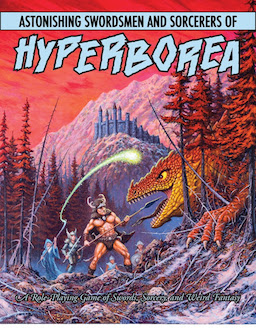 This November 3-5 I had the pleasure of attending the fourth iteration of Gamehole Con in lovely Madison, Wisconsin. At the con I had the additional pleasure of sitting down at Jeffrey Talanian’s table to play an Amazonian Fighter in Jeff’s Lovecraftian adventure “The Rats in the Walls”. I’m not going to give away spoilers here, but the creepy escapade had more to it than rats in walls! And, despite Jeff’s best attempts to kill us, our party overcame its antagonists in an epic last battle of first-level proportions! If you can’t tell from my exclamation points, it was great fun!
This November 3-5 I had the pleasure of attending the fourth iteration of Gamehole Con in lovely Madison, Wisconsin. At the con I had the additional pleasure of sitting down at Jeffrey Talanian’s table to play an Amazonian Fighter in Jeff’s Lovecraftian adventure “The Rats in the Walls”. I’m not going to give away spoilers here, but the creepy escapade had more to it than rats in walls! And, despite Jeff’s best attempts to kill us, our party overcame its antagonists in an epic last battle of first-level proportions! If you can’t tell from my exclamation points, it was great fun!
Jeff’s “The Rats in the Walls” takes place in the City-State of Khromarium. This is an area in Hyperborea, which is the official campaign setting for Jeff’s own roleplaying game that is published by North Wind Adventures. The second edition of Jeff’s game currently is 365% funded on Kickstarter with nine days left to go! After our game, Jeff graciously agreed to an interview with me. Here it is:
What is AS&SH?
AS&SH stands for Astonishing Swordsmen & Sorcerers of Hyperborea, a role-playing game of swords, sorcery, and weird fantasy. It is a tabletop RPG inspired by the fiction of Robert E. Howard, H.P. Lovecraft, and Clark Ashton Smith. Its rules are inspired by the works of Dave Arneson and Gary Gygax. AS&SH was released in 2012 as a boxed set. In 2013, it was nominated for several ENnie awards (Best Game, Best Production Values, Product of the Year), and in 2017 it will be rereleased in Second Edition hardback format.
Why did you create a game specific to the flavor of these writers and these genres? Did this grow out of what they call a “homebrew” game? If so, please tell us about that game and exactly how it resulted in AS&SH?
Growing up, I greatly admired fantasy, science fiction, and horror. I started reading genre fiction at a very young age (most notably the Conan paperbacks, The Hobbit, and The Chronicles of Narnia). I also got into comic books and magazines; Savage Sword of Conan and The Mighty Thor were my favorites. I also devoured sword-and-sorcery themed cartoons and films. I never missed an episode of Thundarr the Barbarian, and films like Conan the Barbarian, The Beastmaster, Hawk the Slayer, and Krull really captured my imagination in those halcyon days. I loved Tolkien, and read Lord of the Rings in the sixth grade, but for me it was always the grittier, more personal tales that I’ve loved most: Conan, Kull, Solomon Kane, Elric, Hawkmoon, Corum, Tarzan, John Carter, Carson Napier, Doc Savage, Gray Mouser, etc.
As a teenager, I was introduced to H.P. Lovecraft, and that was a revelation that really shocked my senses: This was not horror in the sense of werewolves, vampires, mummies, and ghosts; rather, it was cosmic horror not meant to be correlated by our ignorant, little minds. It blew me away! Concurrently I was diving into Herbert, Asimov, Heinlein, Bradbury, and so many other sci-fi greats, and I was taking it all in.

I started running Dungeons & Dragons games in 1981 at the age of ten after my pal Jimmy introduced it to me in our fifth grade class. As a budding DM, I began introducing many of the thematic elements I’d enjoyed reading and watching. So, the idea of introducing sword-and-sorcery themes in my D&D games started at a young age.
Fast forward to the year 2001. I’d been running D&D campaigns for 20 of my 30 years on this globe. Upon the conclusion of a long campaign of AD&D 2E in which Ragnarok consumed the world and all the PCs perished in the ultimate battle, I decided to really explore what is sometimes called a “humanocentric” setting. I wanted to step out from Tolkien’s backyard — no more elves, dwarves, hobbits, and things of that nature. It was a fun change-of-pace from our normal mode of play. We were trying D&D 3E at that time, but I
was modifying the rules to suit my tastes.
Four years later (2005), I was fortunate enough to pick up work for Gary Gygax on the Castle Zagyg project. At this time I returned to high fantasy gaming and all its tropes. I was running a World of Greyhawk campaign, playtesting a modern interpretation of the original adventure that Gary had used to playtest the game of Dungeons & Dragons, and it was quite a thrilling time. I grew up idolizing Gary Gygax, so to earn the privilege to develop his most famous dungeon was an unthinkable honor. I was using the intended system for Castle Zagyg, called Castles & Crusades, but the idea of Greyhawk inspired me to return to my true gaming roots; I had a binder full of house rules that essentially turned the C&C game into AD&D 1E.
Sadly, Gary Gygax passed away (R.I.P.) in 2008. I continued to work on Castle Zagyg, and we released the first part of the series, but ultimately I was deprived of the opportunity to complete the work he’d laid out for me to do. In fact, all of Gary’s creative works were stripped away from his fans, and there is no indication of this stoppage being lifted; a tragic loss for the gaming community. I digress.
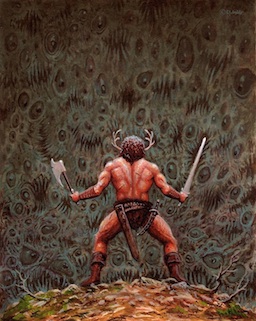
In the aftermath of Castle Zagyg (early 2009), I prepared to start a new chapter in my creative life. This is when I started to develop Astonishing Swordsmen & Sorcerers of Hyperborea. In fact, back then I was just calling it Swordsmen & Sorcerers, but that was too generic. It didn’t express my primary intent: traditional styled rules married to a sword-and-sorcery setting inspired by all the stuff that had inspired me over the years. The game started as a small collection of house rules and a single hand-drawn map. I ran it for my regular group, and it grew from there. By 2012, it was published in boxed set format, and it has been growing ever since. I am very fortunate.
The world of Hyperborea is quite rich. What influences and elements went into its creation? I understand that the world of Hyperborea has a most direct connection to Clark Ashton Smith. What is Smith’s Hyperborea and how does it compare to your own?
My interest in Hyperborea was originally inspired by Robert E. Howard’s Conan. In “Tower of the Elephant” a Hyperborean was introduced, described as so:
In one of these dens merriment thundered to the low smoke-stained roof, where rascals gathered in every stage of rags and tatters— furtive cut-purses, leering kidnappers, quick-fingered thieves, swaggering bravoes with their wenches, strident-voiced women clad in tawdry finery. Native rogues were the dominant element—dark-skinned, dark-eyed Zamorians, with daggers at their girdles and guile in their hearts. But there were wolves of half a dozen outland nations there as well. There was a giant Hyperborean renegade, taciturn, dangerous, with a broadsword strapped to his great gaunt frame—for men wore steel openly in the Maul.
Here my interest was immediately piqued, because Hyperborea was also the place Sinbad had journeyed to in Sinbad and the Eye of the Tiger. I became fascinated by the concept of Hyperborea. I began playing a Conan play-by-mail war game called Hyborian War, and I always selected the kingdom of Hyperborea. I never won that game, but the idea of a nation full of sorcerers and witches fascinated me. Probably should have picked Aquilonia or Nemedia.
I discovered Clark Ashton Smith in the early 2000s. I was immediately hooked. His world of Hyperborea, as well as Averoigne, Polaris, and Zothique really captured my imagination. In fact, you can find Smith’s influence in my Castle Zagyg work. I have a sorcerer who is much like the one found in “The Seven Geases”, as well as gargoyles inspired by CAS’s Tsathoggua.
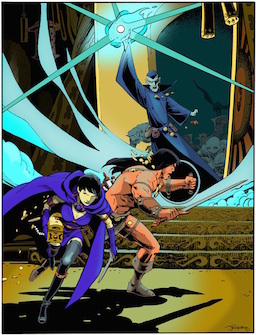
Indeed, I drew heavily from Smith’s Hyperborea as I developed AS&SH. The primary deity in the setting is Xathoqqua (Tsathoggua), the vhuurmis are a race of ape-men inspired by Smith’s humanoids of similar alliteration. At the center of Hyperborea we have a massive extinct volcano where dwells many of the gods in the setting — perhaps Xathoqqua himself. A great worm spawned an ice age millennia ago . . . I could go on and on, but some fans of AS&SH submit that the setting is more inspired by Smith’s Zothique. It has a “Dying Earth” subgenre feel — the bloated red sun, the isle of necromancers, etc.
Why a second edition? What is different about the two editions?
Simply put, we are almost out of the original boxed set. It’s a nice problem to have! So, it was time to go to a new printing, which we decided to execute in hardback format. Once we started adding more art, more character classes, more spells, more monsters, more treasure, and new material in the appendices, David Prata (my editor) and I decided it was time to call this a new edition. But AS&SH 2E will be backwards compatible. The boxed set will not be rendered obsolete with the release of the Second Edition hardback.
What I loved about the first edition is the art. I understand that all the original art is in this edition, as well, but that there also will be new art. Is this new art from artists who haven’t contributed to the first edition? Tell us a bit about this new art and what most excites you about it.
It’s nice to hear the art in the boxed set resonates with you. While that art is fantastic, we felt it was time for a greater degree of variety — new interpretations of Hyperborea. Charles Lang, Val Semeiks, Del Tiegeler, Johnathan Bingham, Peter Mullen, and Daisey Bingham are among the artists working on AS&SH 2E. These artists have all worked on AS&SH material before, so there is a history there, a continuity.
Charles Lang is a fantasy and horror painter from witch-haunted Salem, Massachusetts, and he returns to provide a new cover featuring the same hero found on the original boxed set cover. That same hero is also featured on the back cover painting. Charles continues to improve with age, always trying to outdo himself. His cover work on the Second Edition of AS&SH serves as sort of mission statement.
Val Semeiks illustrated the cover of our adventure module, The Forgotten Fane of the Coiled Goddess, and his work is nothing short of phenomenal. Val is most famous for his work in the comic book industry (Conan the Barbarian, Savage Sword of Conan, Wolverine, Demon, Lobo, etc.). Val is doing 18 illustrations for the new hardback, but the ones that excite me the most are his frontispieces. The AS&SH game is divided into six distinct volumes, and Val’s work will front each of these volumes in full color. That is where colorist Daisey Bingham comes in. Daisey has done color work for AS&SH in the past, including the cover of Forgotten Fane. She enriches Val’s work in gloriously unexpected ways. She is a true gem.
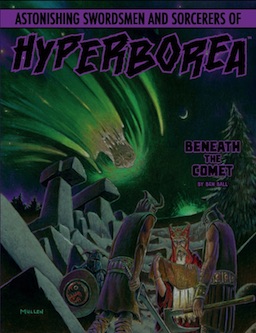
Bringing back Johnathan Bingham was a no-brainer. I started working with John in 2010 with the Taken From Dunwich module. That carried over to Forgotten Fane of the Coiled Goddess, Beneath the Comet, and Ghost Ship of the Desert Dunes. John has a unique style that is immediate, engaging, and action-packed. In recent years he has really fallen in love with the art found in the old mags like Creepy and Savage Sword of Conan, and it really shows! His work on the Second Edition of AS&SH is going to really grab the attention of our readers.
If there is a “most improved” category for AS&SH artists, I would have to give it to Del Teigeler. Del continues to hone his craft, getting better and better with each completed piece. He also did interior work on Forgotten Fane, Comet, and Ghost Ship, as well as the more recent Mystery at Port Greely. Del’s details, camera angles, the facial expressions, and background environments are brilliant compositions. There is so much to look at in a Teigeler picture.
Peter Mullen is deservedly well known in “old school” circles, and his current work on AS&SH may well be his finest. His cover art on Beneath the Comet was so popular that we had a T-shirt made from it. He also did interior work on Port Greely, but the piece that he has recently done that excites me the most is the end papers scene he has illustrated for the AS&SH 2E hardback. It is a sprawling, panoramic, cosmic horror that will start at the front of the hardback and end at the back. It features Xathoqqua worship shared by monster, beast, and man. It is truly an impressive thing.
Two newcomer artists will also have featured work in AS&SH. One is Jason Sholtis, whose work on The Dungeon Dozen really captured my attention a few years ago. Jason’s work has a distinct Clark Ashton Smith feel — this overwhelming sense of dread, horror, and alienness. His compositions make one feel small in a world permeated by Weird. Lastly, we have veteran artist Russ Nicholson, most famous for his work on the AD&D Fiend Folio, Fighting Fantasy, and Warhammer. Russ’s distinct line work is a such a valuable addition to the hardback. He’s got four full-page seascape scenes and a series of daemons that will knock your socks off.
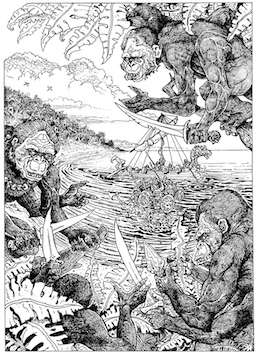
In addition to the game itself, North Wind publishes many stand alone adventures. Though you have written many of these, others are authored by contributors. Will you share your creative process in writing your adventures and what elements you feel are essential to a satisfying adventure and to an AS&SH adventure in particular?
Every adventure I have ever written has started off as a few pages of hand-scrawled notes and a map or two. With the basic blueprint in my hands, I typically run the adventure in its most primal state for my player group, which meets every Tuesday night. I never fail to be surprised by how just a few pages of notes can turn into weeks of exciting play. There is no substitute for playtesting an adventure with your group. Often I take those same notes to conventions, running the same scenario for different groups. As this process progresses, I start formally typing the thing, expanding the maps, and coaxing it into something that may or may not one day be a publishable product. For me, this is a tried and true formula — playtesting and experimenting with content before asking fellow gamers to spend their hard-earned money on it.
To me, the key to a great adventure is setting up something that is interesting and engaging, yet open ended enough that the players can make meaningful choices that impact how the adventure plays out. To be clear, I’m not trying emulate fiction by REH, HPL, or CAS; rather, I’m exploring thematic elements found in their fiction and extrapolating from them in gaming terms. The adventure is merely clay in the hands of the referee and his or her players.
After the AS&SH 2E, what else can we expect from North Wind Adventures in the future?
We have several new adventure modules, each in various states of completion: The Anthropophagi of Xamboola by Corey Walden, The Beasts of Kraggoth Manor by Tim Callahan, and Sea-Wolf’s Saga by me. More adventures are in the pipeline behind these three, including The Strange Tale of Crystal Point and Thousand Eyes of Thaumagorga. You can also expect a major city supplement, The City-State of Khromarium, and last but not least, my own mega-dungeon project. As you can see, it’s an exciting time to be a part of North Wind Adventures! Thank you for your interest in Astonishing Swordsmen & Sorcerers of Hyperborea and North Wind Adventures.
And thank you, Jeff, for giving us this interview! I’m so eager to get this new edition in my hands!
GREAT Q&A. Black Gate needs more stuff like this where we get to hear from folks who are living out their love of RPGs.
I agree with Bob. Awesome interview. I’m a backer of 2E AS&SH. I own 1E but haven’t had a chance to read it much less play it. My gaming group is too much into 5E D&D which I like very much. But I can always steal ideas from other RPGs, if nothing than just the feel and atmosphere.
I’m having the same difficulty getting my group to do anything other than Pathfinder! They’re just regular hobby shop folks, though. As I told Jeff at his table, AS&SH is the game I dream of playing with my most select, dearest and most like-minded friends!
Yeah, this is an excellent Q&A! Definitely would like to see more of this kind of stuff. I’m a backer of the 2E AS&SH Kickstarter also and will be introducing it to my gaming group who are currently only 5e/S&W players but AS&SH should be an easy sell to them since they all love sword & sorcery.
One other thing about Q&As like this, they are great for newer gamers or the ttrpg-curious to read and see the passion that so many creators have for the hobby. I really think it helps them understand more about the hobby.
Patrick